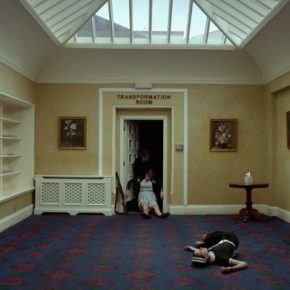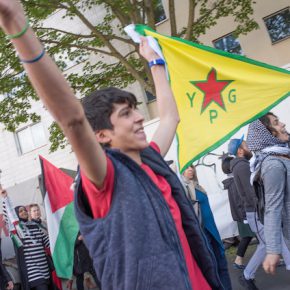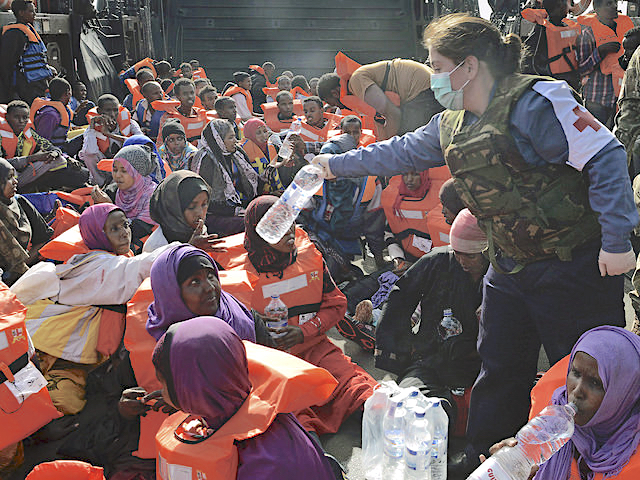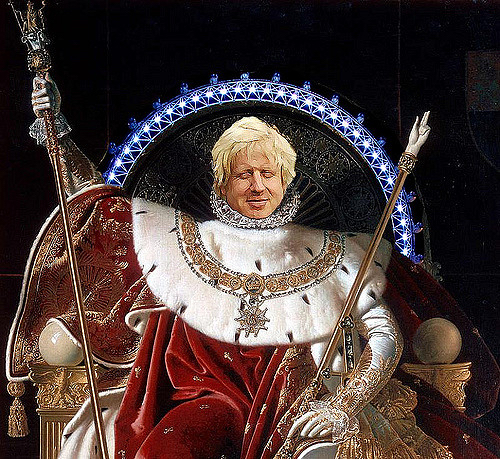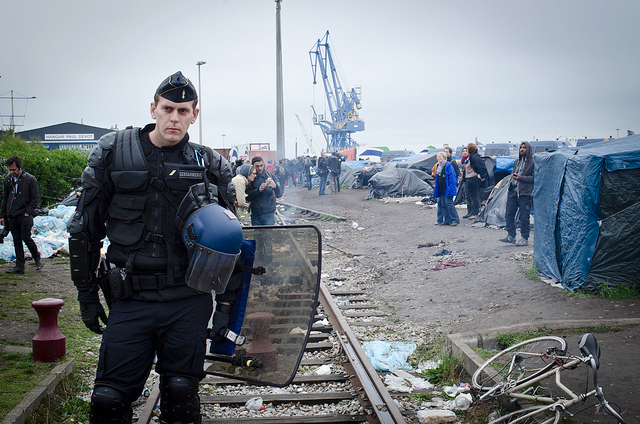The Libyan crisis is not just the product of the NATO intervention. It has endogenous roots worth further examination. Libyan historian Ali Ahmida argues that the country ranks among the most brutal cases of colonial rule. In Africa, this means being in the ranks of Algeria and Congo.
Libya was one of the few Italian colonies, where the fascists put down a nationalist rebellion and erected concentration camps in the desert. 500,000 Libyans were killed under Italian rule and 65,000 of them perished in death camps.
No wonder when King Idriss was overthrown in 1969, the Arab nationalist regime quickly moved to expel the remaining Italian settlers and reverse the work of the pro-Western monarchy. Ironically, the coup d’etat was orchestrated by officers educated as part of the king’s efforts to modernise Libya. The monarchy may have tried to spur development, but it played the role of a conservative bulwark against the tide of nationalism sweeping across the Maghreb.
At first, the new leadership hoped to emulate the example set by General Nasser in Egypt in its show of strength at Suez. At least partially, Ahmida suggests, that this was a delayed reaction to the legacy of colonialism. Yet the Libyan coup came too late in a way. The Arab-Israeli war of 1967 had brought the glory days of Nasserism to a close. Nevertheless, the Libyan regime embarked upon the nationalist path.
The end game
Almost 40 years later, Colonel Gaddafi would fly to Italy and cut a deal worth $5 billion. Upon meeting Silvio Berlusconi, the flamboyant Libyan leader sported a picture on his elaborate military uniform – it was the Libyan Patriots being hung by the Italians. Aboard the plane, Gaddafi had brought the last remaining sons of the resistance fighters. They were there to meet the Italian government.
At this point, Gaddafi was very much welcome in the West. The Libyan regime agreed to seal its borders and crack down hard on migrants trying to reach the coast of Italy. In exchange, the Berlusconi government apologised for its colonial misdeeds and offered the flip the bill for a highway stretching across Libya and linking the state to Tunisia and Egypt. This was touted as a great victory by the regime.
By now, Libya was no longer on the US hit-list for its past role in supporting national liberation movements and terrorist groups. Tony Blair and Nicolas Sarkozy had embraced Gaddafi for abandoning his weapons of mass-destruction programme (if it had ever been real). Soon Anthony Giddens was describing Libya as “the Norway of North Africa”. Everyone wanted a piece of the oil-rich state. Everyone decided to forget the past, or so we thought.
Crucially, the Bush Administration needed to open up Libya to legitimate its own foreign policy objectives. The US invasion of Iraq was credited with helping to bring Gaddafi to re-engage with the West. But the process began long before the Iraq war. After years of sanctions, the Gaddafi regime had calculated it was best to normalise relations and secure its future.
State of the masses
Although Libya is often talked about as if it were an autocracy for over 40 years, the full picture is more complicated. When the monarchy was toppled in 1969, Muammar al-Gaddafi was one of a small clique of army officers and the new leadership was collective. Gaddafi was one of the major figures, but it would be sometime before his position as leader was actually cemented.
The first years of the regime were marked by nationalisation of the economy, social programmes and ambitious infrastructure projects, most notably the Great Man-Made River project – the biggest irrigation system in the world. The Libyan regime was increasingly torn between a pan-Arabist wing headed by Gaddafi and a left-wing nationalist formation. Finally in 1975 the Left moved to oust Gaddafi, but he struck first.
In the aftermath, Gaddafi turned regime towards his own ambitions. The regime began to smother all the institutions, such as trade unions, that had first emerged under the conservative monarchy. Simultaneously, Colonel Gaddafi ploughed money into nationalist organisations around the world, whether it was the ANC, the PLO or the IRA. He was keen to spread his influence far and wide. But he would come to rely on the security apparatus to maintain his power at home.
This situation may not sound particularly unique. Many African and Arab countries are still run on these terms. What made Libya unusual was the scope of informal power. The state expropriated the oil fields, drove out the settlers, established infrastructure projects, as well as public health-care, education and housing. But it was run through informal networks of power rather than longlasting institutions.
Jamahiriya (“state of the masses”) was the phrase Gaddafi would use to describe this arrangement. The state would be reorganised with the people taking part in Basic People’s Committees, which were interlocking and fed into the General People’s Committee. Officially, the country was directly ruled by the masses without a central authority or even political parties. However, this was really about the disavowal of power.
At one point during the Libyan revolution, Gaddafi was asked if he would resign, like Mubarak or Ben Ali, but he insisted he could not step down because he had no post. This was not mere cynicism. On paper, Libya may have been the most democratic country in the world; in actuality, Gaddafi held power. No political organisation was allowed outside of these spaces. Conveniently, this left everything else to one man and his inner circle.
So the Libyan people had no independent trade union movement – something they also have in common with Syrians. And overwhelming political and economic power remained in the hands of the regime. This left the mosque as the natural place where politics could be discussed. Under these circumstances, it may not be surprising that Islamic militancy took hold in places like Derna and would emerge as a major force in the country.
Without the organisational form of the trade union, the Libyan uprising lacked any institutions capable of pursuing economic change. Instead, the key role in bringing down Gaddafi was played by armed groups and the NATO air campaign. These were not stabilisers for a mass movement to capture the state and seize power. Once the tyrant was dead, there was only the vacuum left. This is the real legacy of Colonel Gaddafi’s jamahiriya.
War all the time
Today, Libya is split between militias and rival governments. No one force seems capable of prevailing over all the others. It’s easy to see how the Libyan jamahiriya was bound to leave the country in chaos. But it wasn’t necessarily so. This is why we also have to look at the fall fo the Gaddafi regime in 2011.
In March 2011, we were told that the UN no-fly zone would provide cover for the rebel forces as they advanced against the Gaddafi regime. NATO would bring the hammer down on Colonel Gaddafi just before he could massacre Benghazi, and the Libyan people would be free to pursue their own destiny. Yet this would be far from the end result.
The UN formula was appealing for a lot of liberals and even leftists. The Arab Awakening revived many of the ideals and hopes of Western leftists. Bursting out of Western Sahara, where the Sahrawi people challenged the Moroccan occupation, the revolutionary contagion spread across North Africa and into the Middle East. If Libya could succeed, along with Egypt and Tunisia, Syria would surely be next.
So when the UN proposal for a no-fly zone came along, some leftists looked at Benghazi and saw a case for intervention to clear the space for the rebels to take their revolution to its ultimate end. There were even some progressives arguing that the intervention would allow for a new political system, where trade unions could emerge and jump-start the battle for socialism.
Meanwhile, the humanitarian liberals saw Libya as yet another case where the West must save a hapless people. Libya became Kosovo and Gaddafi was starring as Milosevic. The fear was the regime’s forces would go door-to-door in Benghazi. The answer was NATO bombers. Even for critics of the wars in Iraq and Afghanistan were tempted to see Libya as a ‘good war’. The role of the UN cannot be understated in helping to create this illusion.
After all, the UN is supposed to be an institutional framework for a global consensus. The official proposal was to provide air cover to prevent the bombardment of the rebels, in order to allow for a ceasefire and a negotiated settlement between the two sides. This was clearly not a revolutionary programme, but the consequences were arguably even worse.
In actuality, the UN no-fly zone, supported by most powers in the world, served to open up a space for the NATO powers to pursue their own objectives – which ultimately went far beyond the remit of the UN mandate. The West moved to intervene as soon as the rebels made clear they would respect the old oil arrangements. The mercurial dictator was no longer needed.
Forget the ceasefire. Forget negotiation. Regime change was now on the cards and NATO wanted to take down the regime on its own terms. And so it was. Once the dust cleared, the rebel leadership estimated the war had killed 25,000 people (I previously conflated this figure with the NATO bombing alone, I was too hasty). Others have suggested the figure could be much lower or possibly even higher.
Under the conditions set by Gaddafi, the Libyan uprising faced immense problems with building a new government and a new society. The odds were stacked against the Libyan rebel forces even before the first shots were fired.
Having backed Gaddafi for years, the Western powers now intervened to shape the outcome, not for the sake of democracy, but to reshape the regional consensus. Even on that front, the intervention was a disaster and the break with the past failed to birth a future.
Photograph courtesy of Neil Weightman. Published under a Creative Commons license.

